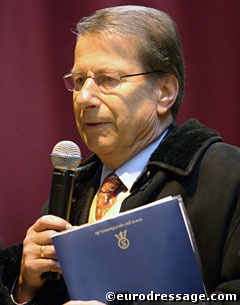
After the first discussions and demonstrations on Tuesday morning, O-judge Volker Moritz stepped up to the plate and set the record straight about the latest rules and regulations concerning the freestyle.
Moritz opened his speech by stressing the importance of a good technical ride over the artistic performance. "Good choreography and music can not compensate for a poor performance," Moritz stated, "classical dressage has to be the highest priority. There has to be harmony between horse and rider; harmony, fluency and forward impulsion in the basic gaits. A raise of difficulty and extra points are only earned if it's performed to the music." The artistic mark, therefore, will depend on the quality of the technical execution.
Moritz recapitulated the rules for junior and young rider tests. For junior riders the half pass in canter is allowed, but not as a zig zag. A junior rider's freestyle should not be more difficult than the JR individual test. If the rider performs a movement not mentioned in the individual test, he will be eliminated. Young Riders can not perform any movements more difficult than those in the Young Riders Prix st Georges test.
In the Intermediaire I kur to music, the performance of a pirouette of more than 360 ° results in a 0 for that exercise. In the Grand Prix kur a double pirouette is the maximum allowed. If a rider performs more than two 360 ° pirouettes he will receive a 0 for that exercise and can not score more than 5 for his choreography. Concerning the piaffe, Moritz stated that it had to be ridden straight for at least 10 steps. Also the piaffe in a pirouette should at least show 10 straight steps before or after it, if the pirouette id used to fulfill the technical requirement.
 Judge Moritz further discussed the following (new) rules. A rider can use maximum 20 seconds of music to enter the ring. The halt and salute has to be on the center line. Riders are not allowed to remove their hat except for the salute. If the music is failing, the rider is allowed to restart, but the marks already given will not be changed.
Judge Moritz further discussed the following (new) rules. A rider can use maximum 20 seconds of music to enter the ring. The halt and salute has to be on the center line. Riders are not allowed to remove their hat except for the salute. If the music is failing, the rider is allowed to restart, but the marks already given will not be changed.
On the topic of "difficult movements" such as the piaffe and passage, Moritz spoke about the importance of the welfare of the horse. Excessive use of difficult movements will not be awarded, nor should the difficult movements be all concentrated at the beginning of the test. Difficult movements are an exceeding number of flying changes or piaffe/passage steps (without exaggerating), difficult transitions from walk to piaffe/passage, harmonious transitions from extensions to collections, and reins in one hand. The judges also expressed their dislike for too many movements performed with the horse's tail facing the judges.
For the artistic level, the judges recommend riders to select music from one genre. Dominant vocals are not appreciated, but minimal vocals can improve the overall impression on the test.
Moritz ended his speech by saying that rhythm, energy, elasticity, and harmony between rider and horse correlate with the technical score. Difficult movements have to be in concordance with the training scale and the arena has to be used as a whole. "75% of the freestyle is technical performance. The riders get the chance to repeat previously failed exercises. Precision is not as important as in the standard tests," Moritz stated.
The complete list of rules on the freestyle will be published on the FEI website.
Text and Images Copyrighted Astrid Appels/Eurodressage.com - No Reproduction allowed without explicit permission